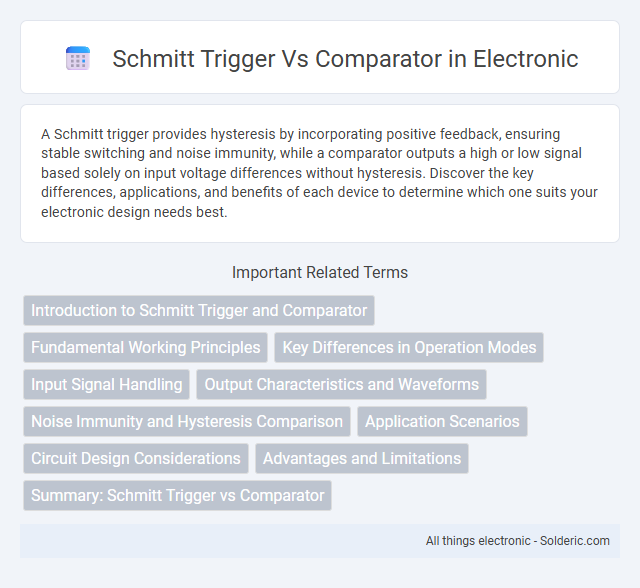A Schmitt trigger provides hysteresis by incorporating positive feedback, ensuring stable switching and noise immunity, while a comparator outputs a high or low signal based solely on input voltage differences without hysteresis. Discover the key differences, applications, and benefits of each device to determine which one suits your electronic design needs best.
Comparison Table
| Feature | Schmitt Trigger | Comparator |
|---|---|---|
| Function | Converts analog input to a digital output with hysteresis | Compares two voltages and outputs digital signal based on comparison |
| Key Characteristic | Hysteresis (two threshold levels) | No hysteresis (single threshold) |
| Output Type | Square wave with noise immunity | Binary digital output |
| Noise Immunity | High, avoids false triggering due to noise | Low, sensitive to noise near threshold |
| Typical Applications | Signal conditioning, debouncing, waveform shaping | Zero crossing detection, analog-to-digital conversion |
| Speed | Moderate | High speed |
| Complexity | More complex due to hysteresis circuitry | Simple design |
Introduction to Schmitt Trigger and Comparator
A Schmitt trigger is an electronic circuit designed to convert a noisy or analog input signal into a clean digital output by providing hysteresis, which prevents rapid switching. Comparators compare two input voltages and switch their output to indicate which input is higher, often used in zero-crossing detectors and ADCs. Your choice between a Schmitt trigger and comparator depends on whether you need noise immunity and signal conditioning or a straightforward voltage comparison.
Fundamental Working Principles
A Schmitt trigger operates by introducing hysteresis through positive feedback, which creates two distinct threshold voltage levels to eliminate noise and provide a stable output transition. A comparator, on the other hand, directly compares two input voltages and switches its output when the input crosses a single threshold without hysteresis. Understanding these fundamental working principles helps you choose the right device for applications requiring noise immunity versus precise threshold detection.
Key Differences in Operation Modes
A Schmitt trigger operates with hysteresis, providing two distinct threshold voltages for switching, which stabilizes noisy input signals and prevents false triggering. In contrast, a comparator switches output as soon as its input crosses a single threshold, offering faster response but lacking noise immunity. Schmitt triggers are ideal for generating clean digital signals from analog inputs, while comparators are suited for precise voltage level detection without built-in noise filtering.
Input Signal Handling
A Schmitt trigger processes input signals with hysteresis, effectively filtering out noise and preventing rapid switching caused by small fluctuations near the threshold. In contrast, a comparator reacts to input signals with a precise voltage threshold but is more susceptible to noise, potentially resulting in unstable output transitions. Using a Schmitt trigger ensures stable signal handling when your input includes slow or noisy variations.
Output Characteristics and Waveforms
Schmitt triggers provide hysteresis in their output characteristics, producing clean, noise-immune square waveforms with well-defined switching thresholds, which prevents output oscillations in noisy or slowly varying input signals. Comparators offer a simple binary output that switches abruptly at a single threshold, often resulting in output waveforms with potential oscillations or noise ringing when the input signal is near the threshold. The hysteresis in Schmitt triggers ensures stable transitions and improved signal integrity compared to the comparator's sharper but potentially unstable switching behavior.
Noise Immunity and Hysteresis Comparison
Schmitt triggers provide superior noise immunity compared to standard comparators due to their built-in hysteresis, which creates distinct upper and lower threshold voltages, preventing rapid output switching caused by small input fluctuations. In contrast, comparators lack hysteresis and can produce erratic output signals when the input voltage hovers near the reference level, making them more susceptible to noise interference. Your circuit benefits from Schmitt triggers in noisy environments as they ensure stable switching and reduce erroneous triggering in comparison to traditional comparators.
Application Scenarios
Schmitt triggers are ideal for signal conditioning in noisy environments, ensuring clean digital transitions in sensor inputs and switch debounce circuits. Comparators excel in high-speed analog-to-digital conversion and threshold detection where precise voltage level comparisons are critical. Both devices serve distinct roles in electronics, with Schmitt triggers enhancing noise immunity and comparators providing rapid, accurate voltage discrimination.
Circuit Design Considerations
Schmitt trigger circuits incorporate hysteresis by adding positive feedback, which stabilizes output transitions and reduces noise sensitivity, making them ideal for noisy input signals. Comparators, designed without hysteresis, provide fast response times and high gain but can produce multiple output transitions with slowly varying inputs due to noise or slow signal edges. Circuit designers must consider the signal environment and desired noise immunity when choosing between the Schmitt trigger's threshold hysteresis and the comparator's rapid switching characteristics.
Advantages and Limitations
Schmitt triggers offer the advantage of hysteresis, which provides noise immunity and stable output transitions in noisy or slow-changing input signals, making them ideal for signal conditioning and waveform shaping. Comparators excel at fast, precise voltage level detection without hysteresis, enabling high-speed applications but are more susceptible to noise and output chatter in noisy environments. Limitations of Schmitt triggers include slower response times compared to comparators, while comparators may require external hysteresis circuits to improve noise immunity.
Summary: Schmitt Trigger vs Comparator
A Schmitt trigger integrates hysteresis to provide a stable output by introducing two distinct threshold voltage levels, minimizing noise and signal oscillations in input signals. Comparators offer precise analog voltage comparison and switch outputs rapidly but lack inherent hysteresis, making them prone to output chatter with noisy or slow-changing inputs. Schmitt triggers suit noisy environments or slowly varying signals, whereas comparators excel in high-speed, noise-free voltage comparison applications.
schmitt trigger vs comparator Infographic

 solderic.com
solderic.com